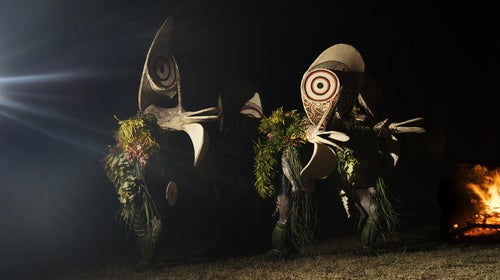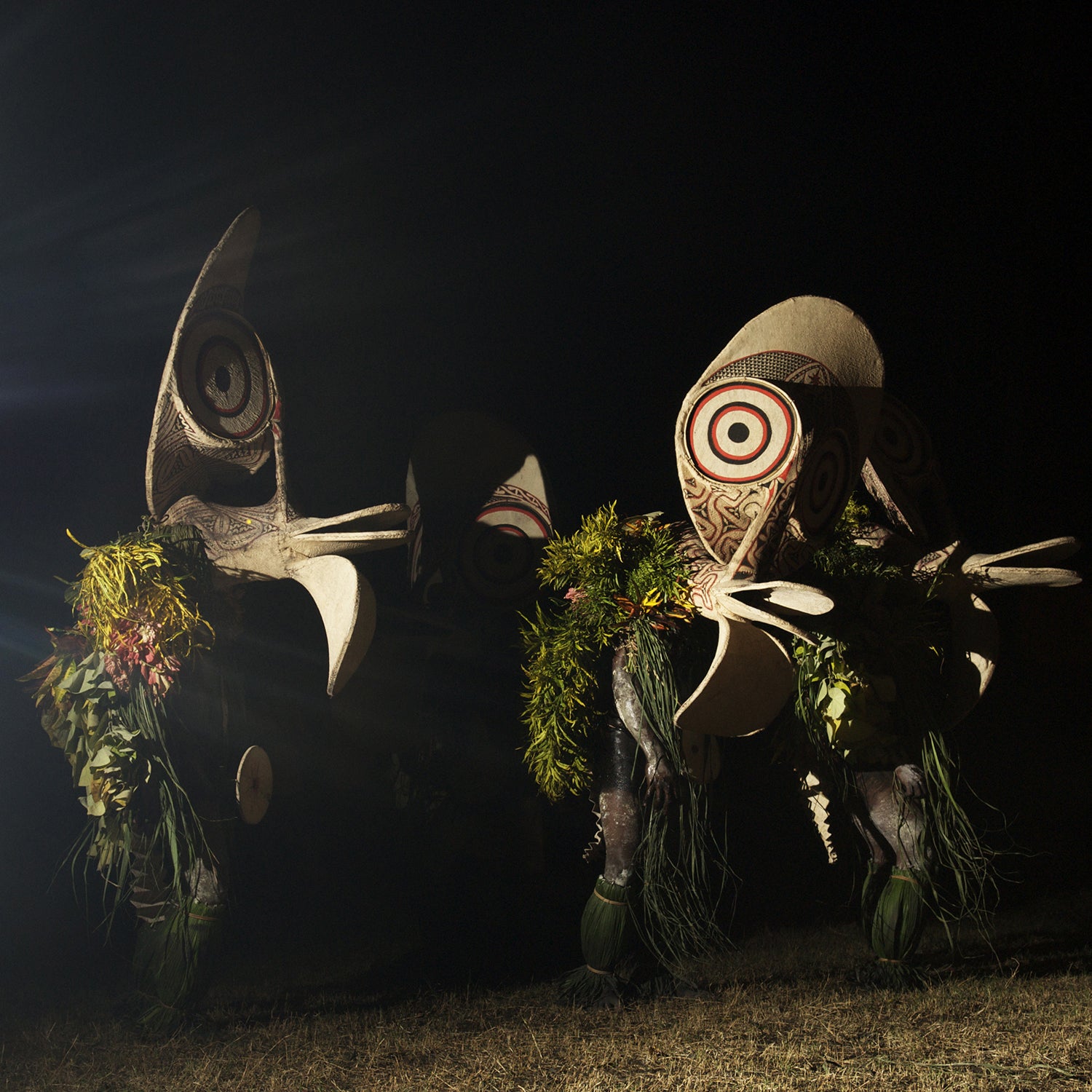It’s one of the most enduring unsolved mysteries of the 20th century: the disappearance of Michael Rockefeller off the south coast of Netherlands New Guinea in 1961. Despite an extensive search overseen by his father, New York Governor Nelson Rockefeller, no trace of Michael was found, nor has any been found since. The open-ended mystery has proven to be catnip for generations of journalists, filmmakers, and adventurers and is now the subject of , a documentary directed by filmmaker Fraser Heston that debuted on Netflix this month.
While the fate of the 23-year-old Harvard graduate remains unknown, the broad outlines of his final days are undisputed. The heir was on an expedition to collect woodcarvings by the Asmat people when his jury-rigged catamaran overturned. His two local guides swam to shore while Rockefeller and Dutch anthropologist Rene Wassing stayed with the boat as it drifted out into the Arafura Sea. The next day, perhaps 10 miles offshore, but likely closer, Rockefeller decided to swim for it. His famous last words to Wassing, who stayed with the boat and was rescued by a search party the next day: “I think I can make it.”
The question of whether he made it to shore remains unanswered. Into the void swept a number of fanciful theories—he had orchestrated his own disappearance, or he was being held in a remote village as a captive god—but the debate has consolidated around two possibilities: He was lost at sea, or he made it to shore where he was killed and possibly eaten by a group of natives in an act of revenge for the 1958 killing of several villagers by a Dutch colonial patrol.
Unlikely as it may seem, it is the killed-and-eaten theory that has convinced many of us. That’s the tentative conclusion I reached in 2008, when this magazine and the Travel Channel sent me to New Guinea to investigate. And it’s the conclusion author Carl Hoffman came to after a far more thorough investigation than my own, detailed in his 2014 book . It’s also the conclusion reached by Milt Machlin, the editor of men’s magazine Argosy, who, in 1969, embarked on one of the first and, as it turned out, most quixotic investigations into Michael’s disappearance.
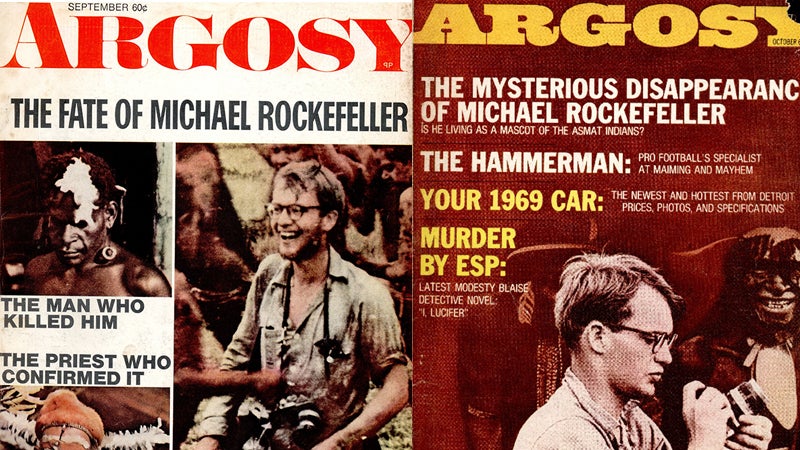
Machlin’s journey began, in his telling, with a visit from a shady (and possibly, some would argue, fictive) Australian named Donahue. “Suppose I told you that I saw Michael Rockefeller alive only 10 weeks ago?” the man allegedly asked before launching into a tale of having seen Rockefeller in the Trobriand Islands, hundreds of miles from where he had disappeared. Machlin bit and embarked on a wild goose chase. Though he never made it to the Asmat himself, Machlin managed to track down and interview missionaries who were there at the time of Rockefeller’s disappearance, eventually releasing a book chronicling his quest, , in 1974.
That book is the basis for Heston’s documentary, and while it may seem like a story that’s hard to advance at this point, Heston has a secret weapon: hours of never-before-seen film footage shot all over New Guinea during Machlin’s journey, including color footage of the Asmat in 1969.
I spoke with Heston about his, and Machlin’s, film.
OUTSIDE: There’s an echo of Donahue’s question to Machlin in your quest for Milt’s footage: What if I were to tell you that there is a trove of unglimpsed Asmat footage from the 1960s that’s been just sitting around somewhere for decades?
HESTON: It is surprising, and we never understood why it was never edited or released. My producing partner and I were doing research for another project and came across Milt’s book and fell in love with it. We optioned the screen rights to it, and then read that Milt took 10,000 feet of 16 mm film and two Bolex cameras with him, and that he hired a cinematographer. So I was intrigued. In 2008, I asked his widow, Margaret Machlin, what happened to the footage, and she said they never really did anything with it and eventually gave it to a stock-footage house. I started digging around, and it turned out that a guy who lived in England had the footage stored in a warehouse. We got in touch with him, and about three months later, three boxes of 16 mm film—without sound, mind you—arrived at my office. I opened it up and started spooling through it—by hand, you know, holding it up to the window, because who has a 16 mm viewer anymore?—and I sort of went, “Oh my God, this is amazing stuff.”
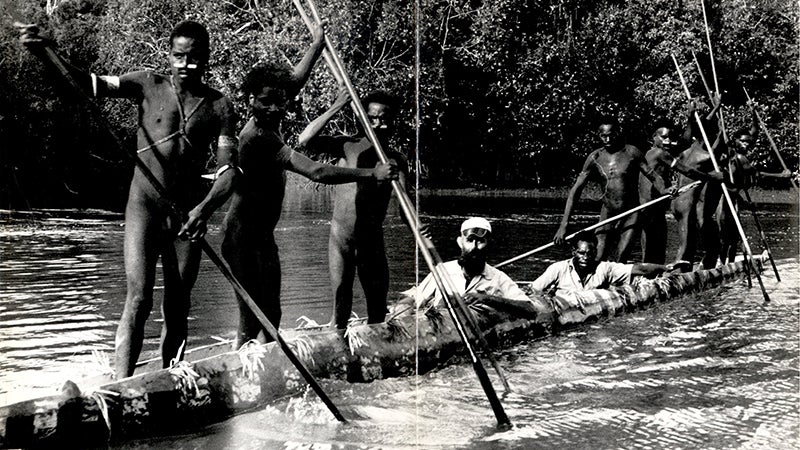
It is an amazing flashback to a time when Asmat culture was nearly as intact as it was when Michael had been there. And it’s in color! But it also sounds like it was a colossal mess when you got it, right?
Oh, no doubt. I thought it was a finished film that was just sitting somewhere, and even after we got the film, I still thought we had a movie in a box and that it would take us maybe six months to finish it. But what we had were maybe 15 reels of various sizes, maybe 10 hours of film or something like that, and no sound!
We eventually found the sound tapes in Margaret’s apartment in Manhattan, in Milt’s study, which was this fantastic treasure trove full of old trunks and leopard skins and elephant tusks and maps. I climbed up a ladder and felt around in the back of one of his old wooden filing cabinets and pulled out a tape reel that was labeled “Interview with Father Van Kessel, Re: Disappearance of Michael Rockefeller.”
Just syncing that stuff up with the footage was a colossal job, and it was made harder because the footage was all chopped up; bits and pieces were missing. It was almost a job of forensic archaeology, like putting together a huge jigsaw puzzle.
[quote]“As far-fetched as it sounds that he might have been there, eight years later, paddling a canoe, that’s kind of the uncertain world that we’re dealing with here.”[/quote]
The Rockefeller family, of course, has always stood by the official story that Michael was lost at sea and never made shore. But you, like others who have looked at it, lean toward the killed-and-eaten theory.
When my editor was able to sync all that stuff up, and we put the sound to Milt’s interview with Father Van Kessel [a Dutch missionary who was posted to the Asmat area in 1955], I was really impressed. We had a supposedly unbiased report from a missionary who had lived among the Asmat and, if anything, had reason to lie to protect them. He made a very strong suggestion that Michael may have been killed and eaten by cannibals. And there was an interview with another missionary, Ken Dresser. He doesn’t comment on film, but the cameraman reports that Dresser believed Michael was killed and eaten by cannibals. I was pretty much convinced by Milt’s logic, those interviews, and the case he lays out in his book. And I think Milt deserves more credit here. His was certainly the first published serious book that expounded on the theory that Michael was killed and possibly eaten by Asmats as revenge for the Dutch patrol that had killed several villagers in 1958.
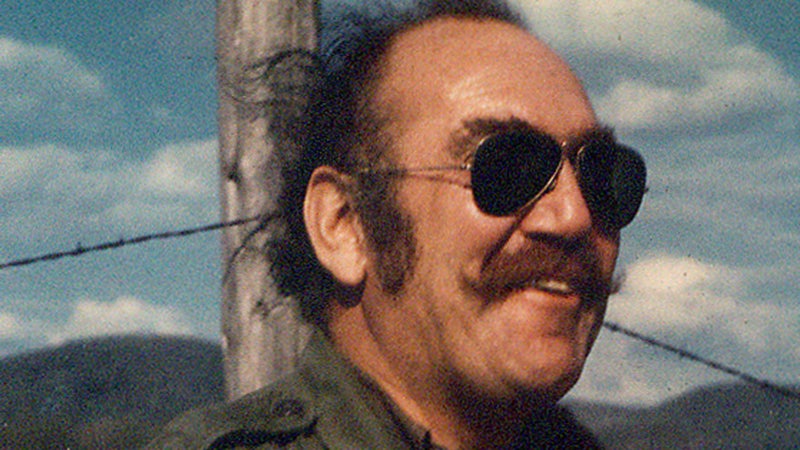
His footage certainly adds some color and depth to the Rockefeller canon. This probably won’t be the last word on this story, either, but do you think there’s anything left to say on it?
It seems that whenever somebody comes out with something, whether it’s Milt’s book or Hoffman’s book or our film or your film, it gets a lot of interest. People are not bored by it, and it does have that kind of almost mythical quality to it: The son of a famous, incredibly wealthy American politician disappears in the jungles of New Guinea and may have been eaten by cannibals. I mean, really, it’s almost too good a story to be true. But whether or not we definitively know what happened, he did disappear there, and at the very least, I think there’s an extremely strong chance that he made it ashore.
Which is where the uncertainty begins and why the story continues to thrive—you can’t ever really claim to have solved it.
No, you can’t. None of us can. As you say, we’re all just contributing to the canon, and I think the public has proven a willing listener and a keen audience for this kind of thing
It’s the mystery that keeps on giving. Can you tell me about “Big Michael”?
I was in a hotel room in New York, sort of speed-watching these DVDs I had made from the 16 mm film. I don’t remember whether I stopped on it by chance or if it went by and I ran it back. But as I progressed through it one frame at a time, I thought, “That guy’s a white guy.” And then my editor blew it up to see what we could learn—that’s when he started calling the shot “Big Michael.” And there’s just no question in my mind that this is not a full-blooded native Asmat, and at that point, I just went, “Wow, this throws a wrinkle in it, doesn’t it?”
It’s also kind of a perfectly surreal cap to retelling this story—a fresh vein of mystery here seems only appropriate.
That’s right, you spend all this time building up one case, and then suddenly you find another layer that turns you in a different direction. So when we found “Big Michael,” I said, wait a second. I’m certainly not saying it is Michael. It’s very grainy, it’s very small, and there’s really no way to do facial analysis or anything like that. But it does look, at least superficially, like him. So I thought if that’s not Michael—and it would have been eight years after he disappeared—who is it? As far-fetched as it sounds that he might have been there, eight years later, paddling a canoe, that’s kind of the uncertain world we’re dealing with here. And that’s part of the attraction of the story.
(This conversation has been edited and condensed.)
